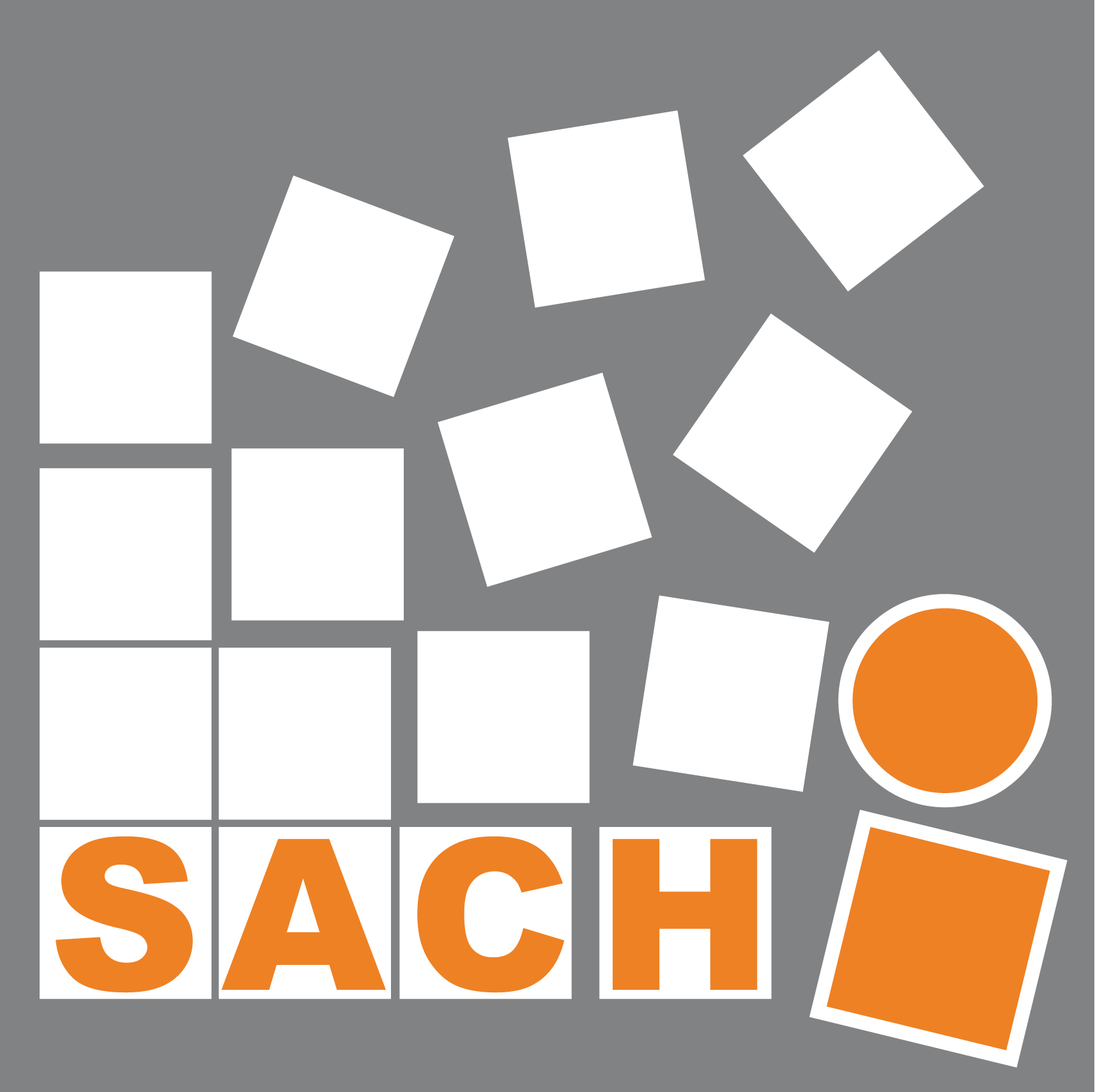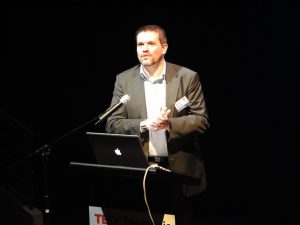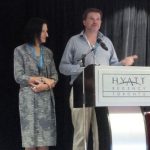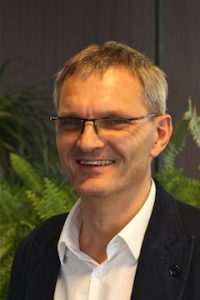<!–Speaker: Neal Lathia, Cambridge University
Date/Time: 2-3pm October 28, 2014–>
Location: Maths Lecture Theatre D, University of St Andrews
Abstract:
In the UK, more than 70% of mobile users now own a smartphone. These increasingly powerful, sensor-rich, and personal devices present an immense opportunity to monitor health-related behaviours and deliver digital behaviour-change interventions at unprecedented scale.
However, designing and building systems to measure and intervene on health behaviours presents a number of challenges. These range from balancing between energy efficiency and data granularity, translating between behavioural theory and design, making long psychological assessments usable for end users, and making sense of the sensor and survey data these apps collect in a multidisciplinary setting.
Approximately 18 months ago, we launched Emotion Sense, a mood-tracking app for Android where we tried to address some of these challenges. To date, the app has been downloaded over 35,000 times and has an active user base of about 2,000 people: in this talk, I will describe how we designed, trialled, and launched Emotion Sense, and the insights we are obtaining about diurnal patterns of activity and happiness that we are finding by mining the 100 million+ accelerometer samples the app has collected to date. I’ll close with future directions of this technology — including a novel smoking cessation intervention (Q Sense), and a generic platform (Easy M) that we have developed to allow researchers to conduct their own studies.
http://emotionsense.org/
http://www.qsense.phpc.cam.ac.uk/
http://www.cl.cam.ac.uk/~nkl25/easym/
Bio:
Neal is a Senior Research Associate in Cambridge University’s Computer Laboratory. His research to date falls somewhere in the intersection of data mining, mobile systems, ubiquitous/pervasive systems, and personalisation/ recommender systems, applied to a variety of contexts where we measure human behaviour by their digital footprints. He has a PhD in Computer Science from University College London. More info/contact http://www.cl.cam.ac.uk/~nkl25/
This seminar is part of our ongoing series from researchers in HCI. See here for our current schedule.
News
Aaron Quigley has been invited to the Winter Augmented Reality Meeting 2015 as a Keynote Speaker. WARM is an interdisciplinary meeting of experts in AR and related domains running its tenth installment. WARM2015 continues the success of previous WARM events (WARM’05, WARM’07, WARM’08, WARM’09, WARM’10, WARM’11, WARM’12, WARM’13, WARM’14).
The organisers of WARM’15 note that the fields of Computer Graphics, Augmented Reality, Computer Vision and Ubiquitous Computing are synergistic. However, the overlap and interleaving contributions of each area has yet to be expressed and understood. The domain expert, focusing and on excelling in his or her field of research, is unable to see the connections. This meeting is a fertile ground to connect ideas and therefore seeks a variety of topics revolving around Augmented Reality and Ubiquitous Computing.
Aaron is currently on sabbatical in Japan conducting research and working on a book. Elements from both of these will form the basis for his keynote lecture in February 2015 at Graz University of Technology, Institute for Computer Graphics and Vision, Austria.
The title for his talk will be “Constructing Reality: Digital-Physical Scaffolding” and the abstract is,
Abstract:
Is the relationship between human and computer akin to a dance, where each moves effortlessly responding to the movements of the other? Or, are computers just agents who do our bidding, either undertaking direct actions on our behalf or proactively determining services, information and supports we may need on a moment to moment basis? Or, should computers continue to be best thought of as simple devices which we should turn over work to as Vannevar Bush said or thinking assistants to perform the routinizable work as Licklider suggests while we focus on creative thought and decision? Neither the beautiful dance, the agent nor the simple device seems to capture our current experience of human computer interaction. Technology underpins the human experience and digital technologies in the form of devices, computers and communications are weaving themselves into the fabric of existence. The nature of this weaving is far from uniform, distributed or even fair. For some, the impact of digital technologies are far removed from their day to day life and serve only to support some of the infrastructure of where they live, if at all. For others, digital technologies form part of the substrate of their existence and living without their mobile phone, social media apps and streaming music service seems unimaginable. Between these extremes are broad swathes of the global population who rely on digital technologies for the infrastructure in their areas and services delivered to their homes. Of course, our use and indeed reliance of technology is not new. Indeed, it is one of the defining characteristics of humans and society, our fashioning of tools, instruments and technologies to help shape our world and lives. In this talk I will discuss how we have already used technology to fashion and construct our present reality and explore ways we might create new scaffolds for the future such as enhancing our senses for a myriad of reasons from correction to replacement and enhancement.
In late September 2014 a number of members from SACHI were involved with MobileHCI 2014 in Toronto Canada. Aaron Quigley was the general co-chair for this conference and Daniel Rough was the registration chair. Per Ola Kristensson, an external member of SACHI, presented a paper and was a session chair during the conference. MobileHCI brings together people from diverse areas which provides a multidisciplinary forum for academics, hardware and software developers, designers and practitioners to discuss the challenges and potential solutions for effective interaction with and through mobile devices, applications, and services.
 This year MobileHCI was able to have a single track for the entire program which allowed everyone to see all the papers, posters, demos, design contest, panels etc. without trying to change sessions. Some images from this conference can be found here. Aaron is now the chair of the MobileHCI conference series steering committee until August 2015.
This year MobileHCI was able to have a single track for the entire program which allowed everyone to see all the papers, posters, demos, design contest, panels etc. without trying to change sessions. Some images from this conference can be found here. Aaron is now the chair of the MobileHCI conference series steering committee until August 2015.In early October a number of SACHI members were again involved with or attended UIST 2014, the ACM Symposium on User Interface Software and Technology. We organised this conference, UIST 2013 here in St Andrews last year. In 2014, Per Ola Kristensson was the demo co-chair and Jakub Dostal was the registration co-chair. Per Ola was also awarded a lasting impact award during UIST 2014. Aaron Quigley will be the keynote chair for UIST 2015 in Charlotte, NC Nov 8-11, 2015.
 The ACM Symposium on User Interface Software and Technology (UIST) is the premier forum for innovations in human-computer interfaces. UIST brings together people from diverse areas including graphical & web user interfaces, tangible & ubiquitous computing, virtual & augmented reality, multimedia, new input & output devices, and CSCW.
The ACM Symposium on User Interface Software and Technology (UIST) is the premier forum for innovations in human-computer interfaces. UIST brings together people from diverse areas including graphical & web user interfaces, tangible & ubiquitous computing, virtual & augmented reality, multimedia, new input & output devices, and CSCW.You can read Aaron’s full blog post about the papers he noted to SACHI here.
<!–Speaker: Professor Janet C Read, University of Central Lancashire
Date/Time: 2-3pm October 14th, 2014
Location: Maths Lecture Theatre B, University of St Andrews–>
Abstract:
The process of learning to write is both cognitive and motoric. Forming symbols into words and committing them to a surface is a process laden with complexity; creating the meaning that will be represented by these words is even more complex.
Digital technologies provide opportunities and insights for the study of writing processes. With keyboard capture and pen stroke capture important information can be gathered to make writing systems more child suited and to provide useful assistance to beginner writers. Data captured during the electronic transcription of writing can also provide insights into how writing emerges as a form.
This talk will present child computer interaction against the context of children writing using electronic means. The marriage of the text input space, the digital ink space and the child will be explored using examples from recent research.
Bio:
Prof. Janet C Read (BSc, PGCE, PhD) is an international expert in Child Computer Interaction having supervised 7 PhD students to completion, examined 14 PhD students in six different European countries and currently supervising 8 PhD students studying a range of topics including the use of colour in teenage bedrooms, the design of interactive systems for dogs, the use of scaffolding in serious games, the use of text input to detect fraudulent password use, collaborative gaming for children, evaluation of systems for children and the forensic detection process. Her personal current research is in three main areas – she has recently published several papers on the ethics of engaging with children in participatory research activities offering a model for working with children which ensures they are given full information, and also a set of techniques that can be used to ensure that children’s contributions to interaction design are treated with respect. A second strand of interest is in the study of fun and the study of means to measure it. The Fun Toolkit, which is a set of tools to measure the experience of children when using interactive technology, is her most cited work and this is work that has developed over time but is still being examined. The uses of digital ink with children, and the whole area of text input for children, both with standard keyboards and with `handwriting recognition completes her current research portfolio. Professor Read has acted as PI on several projects (see below) and is the Editor in Chief of the International Journal of Child Computer Interaction.
This seminar is part of our ongoing series from researchers in HCI. See here for our current schedule.

Dr Per Ola Kristensson, one of the cofounders of SACHI, has become a University Lecturer in the Department of Engineering at the University of Cambridge. In his time at St Andrews he helped to establish the teaching and research footprint for HCI across the School of Computer Science. Speaking to SACHI Per Ola said, “I have enjoyed my time in St Andrews tremendously. It is an incredibly stimulating and vivid research environment and the growth and international visibility of the St Andrews Human Computer Interaction (SACHI) group is a testament to this.” The students here will miss him as will his colleagues. Working with students is clearly close to Per Ola’s heart, as he noted that “both the undergraduate students and the MSc students I have been teaching have been fantastic. It is incredibly rewarding to teach HCI to motivated students.”
Per Ola helped establish SACHI in many ways, from bringing leading researchers to our seminar program to new funded research projects. Professor Aaron Quigley said, “We will all miss Per Ola very much. His energy and razor sharp intellect helped in our research, teaching and in developing new insights into challenging problems”. Per Ola went on to say that, “the collegial atmosphere is superb and the intellectual environment in the SACHI group has resulted in many papers at CHI, AVI, IUI, etc. co-authored together with colleagues, PhD students or undergraduate students. Some of these papers have also been featured in the international press or won best paper prizes.”
During his time with St Andrews, Per Ola had many successes from being awarded the RSE/Makdougall Brisbane Medal to being the only UK member of the TR35, the most prestigious annual list published by MIT TechnologyReview in 2013. Speaking of Per Ola as an academic Aaron said , “While Per-Ola has some serious business credentials under his belt, he is a true academic scholar, in every meaning of that term. He values academia deeply and understands that high quality research with impact doesn’t come overnight. Instead, it comes with deep thought, studious application of suitable methodology and care in reporting research results”.
Speaking about the School of Computer Science and the University Per Ola said, “people here have a genuine belief in academic values and the importance of ensuring teaching and research is of the highest calibre.” Dr Miguel Nacenta, another of Per Ola’s colleagues added, “Per Ola has been a great colleague and a friend. Working with him has enriched all of us at SACHI and we hope that the strong ties that we keep with him result in many more fruitful collaborations.”
Dr Per Ola Kristensson is now a Honorary Reader in the School of Computer Science and continues to be a member of SACHI. Looking back on his time in St Andrews Per Ola noted, “these years I have spent in St Andrews have helped me develop as a researcher and a teacher and I will remember my years here fondly”. We all wish Per Ola well on the next step in his career, it has been our great pleasure to work together for these past few years.
We are delighted to welcome Jonathan Hughes as an honorary research fellow to SACHI and the School of Computer Science. Jonathan is Founder & CEO of Butterfly Catcher and was formerly a founder employee of Realtime Worlds Inc., helping to create the BAFTA-winning videogame franchise ‘Crackdown’ for Microsoft Game Studios. As Principal Designer there he was also responsible for the design direction of ‘MyWorld’, a hugely ambitious entertainment platform which secured $50m funding from NEA and WPP, with executive design oversight of the UK and Asia-Pacific projects. After running the software development agency Zedaxis for several years, with clients such as Skyscanner and the NHS, he founded Butterfly Catcher in 2012, focusing on data visualisation for industry, and in particular finance.
Commenting on his honorary fellowship Jonathan said “I’m delighted to be appointed to this role. Aaron’s team at SACHI have a tremendous reputation and they are undertaking world-leading research which is highly applicable to industry. Being given the opportunity to be involved is very exciting indeed.”
Jonathan has a Masters (Dual Hons) in Psychology & Philosophy from the University of St Andrews, where he specialised in visual perception so this is a return home of sorts! Professor Aaron Quigley said of this fellowship, “we are delighted to have Jonathan join us and we are looking forward to many fruitful collaborations. With his 15 years of industrial experience across a wide range of industry sectors, Jonathan brings a new dynamic to SACHI which we are looking forward to.” Jonathan will contribute to St Andrews HCI research (SACHI) with respect to seminars, involvement in informal supervision, exploration of joint research projects, advice on information visualisation and the finance sector along with working with staff and students on research projects. We also expect Jonathan to provide advice on Palimpsest along with developing new projects and ideas with collaborators within SACHI (both within St Andrews and across Scotland).
<!–Speaker: David Harris-Birtill, University of St Andrews
Date/Time: 2-3pm September 23rd, 2014–>
Location: Maths Theatre D
Abstract:
This talk outlines David Harris-Birtill’s previous research (at the Institute of Cancer Research and Imperial College London) focusing on applications in detecting and treating cancer. The talk will discuss photoacoustic imaging in the clinic, photothermal therapy with gold nanorods, and the advantages of imaging in a variety of settings and in it’s many forms from a nano to a macro scale to help the fight against cancer. This talk will also touch on the importance of displaying the right type of information to the right type of user and why data analysis skills are so important in efficient scientific research.
For any questions please email David on dcchb@st-andrews.ac.uk
Bio:
Dr David Harris-Birtill is a Research Fellow in the School of Computer Science at the University of St Andrews. His current research is in human computer interaction and information visualisation, and is particularly interested in data analysis, sensors and automising research.
David’s work has been published in journals including Astronomy and Astrophysics and the Journal of Biomedical Optics, and has presented his research across the globe at conferences including San Francisco (SPIE Photonics WEST) and Hong Kong (Acoustics 2012). He has created open source image analysis programs which have been downloaded by over 100 researchers all over the globe, has run a course on “Introduction to Matlab for busy researchers and clinicians” and supervised research by Masters and PhD students.
This seminar is part of our ongoing series from researchers in HCI. See here for our current schedule.
We’re delighted to announce the launch of the new SICSA knowledge exchange theme: Medical Imaging and Sensing in Computing. Led by Dr David Harris-Birtill from the University of St Andrews’ SACHI group, David has been awarded full funding for a series of events to foster new development and collaboration on this topic. (see full SICSA news item)
The theme will run until 31st July 2015 and will have events open to all universities in Scotland, stimulating new ideas, connections and collaborations in this exciting and dynamic field. Dr Robert Davey from Toshiba Medical Visualization Systems is the industry expert who will also be working with us on this theme, providing useful input on the commercial application of this area.
What does the new SICSA knowledge exchange theme cover?
Computing has provided significant technological advancements within medicine over the last decade, contributing to medical imaging within MRI and X-ray CT, PET and ultrasound and optical imaging, and in recent years, advances in smart phones and wearable sensors have also enabled patients and clinicians to get complementary information. These imaging and sensing advances impact the general population as they have found methods to detect cancer, detect arterial plaque which leads to heart attacks, and guide cancer radiotherapy treatments by providing information on how much radiation dose to give to which parts of the body.
By starting this new SICSA theme, Medical Imaging and Sensing in Computing, like-minded researchers across Scotland can form a new intellectual community, promote their research, and foster creativity across institutions and collaborations between academia and industry. In addition, computer scientists involved in other research fields, such as machine learning, will be invited to connect their relevant work to the field of medicine, sparking innovative new projects. Toshiba Medical has highlighted that local industry needs to connect with talented young academics to help stimulate new ideas, engage with academia to find joint funding for industry focused research, and attract talented personnel for recruitment in such a rapidly-growing field.
New areas of research and development needed within industry include extracting useful medical information from wearable sensors, and getting information from large data sources, such as vast medical image and data stores, to help detect disease earlier and make chronic illnesses more treatable. Ultimately this theme enables researchers from across Scotland at all stages of their careers to make meaningful connections with other academics and industry members, to work together to improve patients’ lives. We look forward to the first event!
Professor Harald Reiterer will visit SACHI in St Andrews from October of 2014 until March of 2015 on his research sabbatical. Together we have established ideas for new interaction paradigms for Distributed User Interfaces, like Blended Interaction. Harald visited SACHI in March 2013 and gave an invited talk about this topic. To discuss and present our ideas a greater audience we have organized together with a CHI 2013 workshop around this topic (More information are available here: http://hci.uni-konstanz.de/blendedinteraction2013/). As a follow up activity of the CHI 2013 workshop we organized in November 2013 a Dagstuhl Seminar called “Proxemics Interaction in HCI” (More information available here: http://www.dagstuhl.de/de/programm/kalender/semhp/?semnr=13452 ). Since this, we have submitted an EU grant proposal together and our students have started collaborations and follow up research.
Next month Dr. Eve Hoggan who is a research fellow with the Helsinki Institute for Information Technology HIIT, Aalto University, Finland will visit SACHI until December. This visit is funded by the Academy of Finland as part of Eve Hoggan’s project – AbiComm: Ability-Based Multimodal Communication. The purpose of this research is to create a mediated interpersonal communication system adapted to the abilities of individual users.







